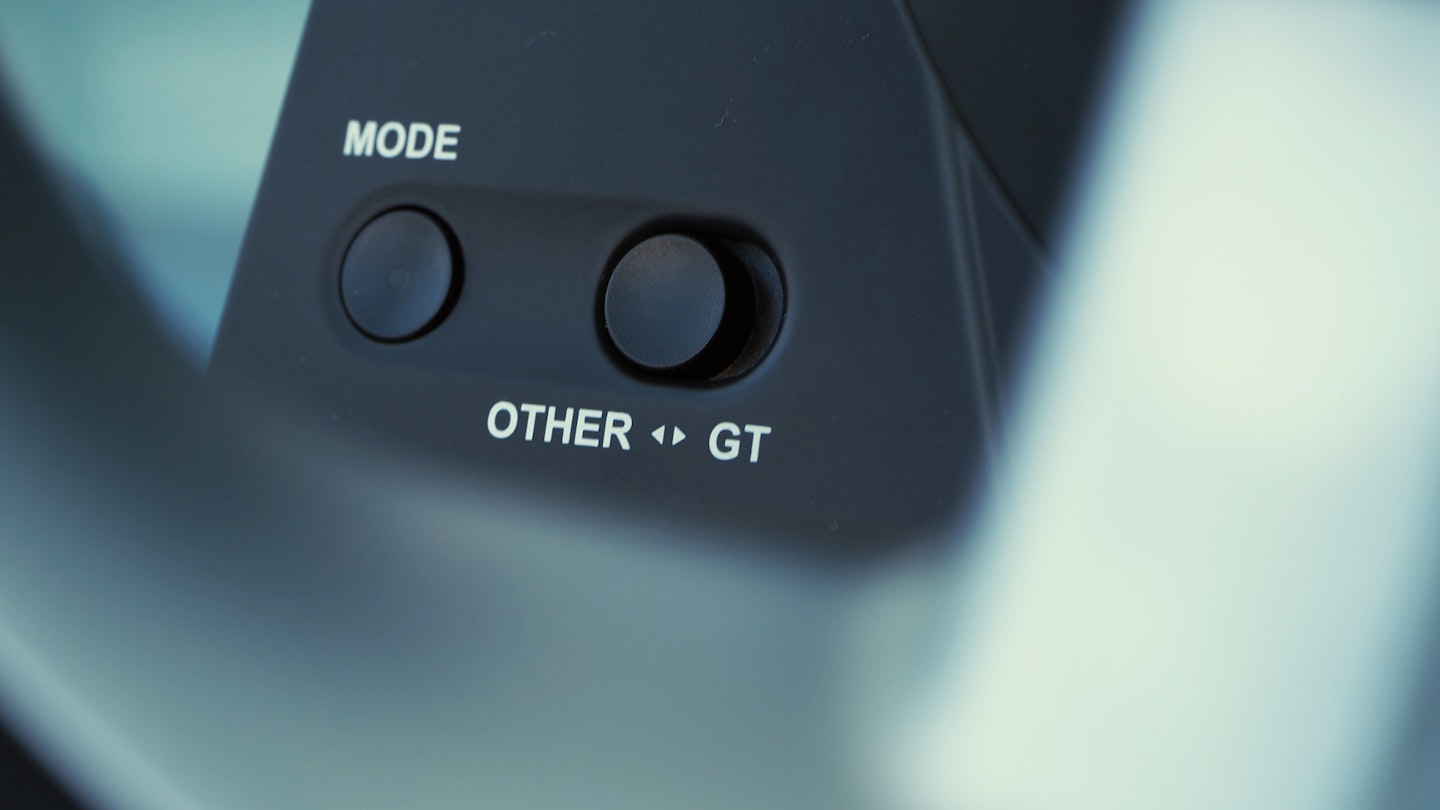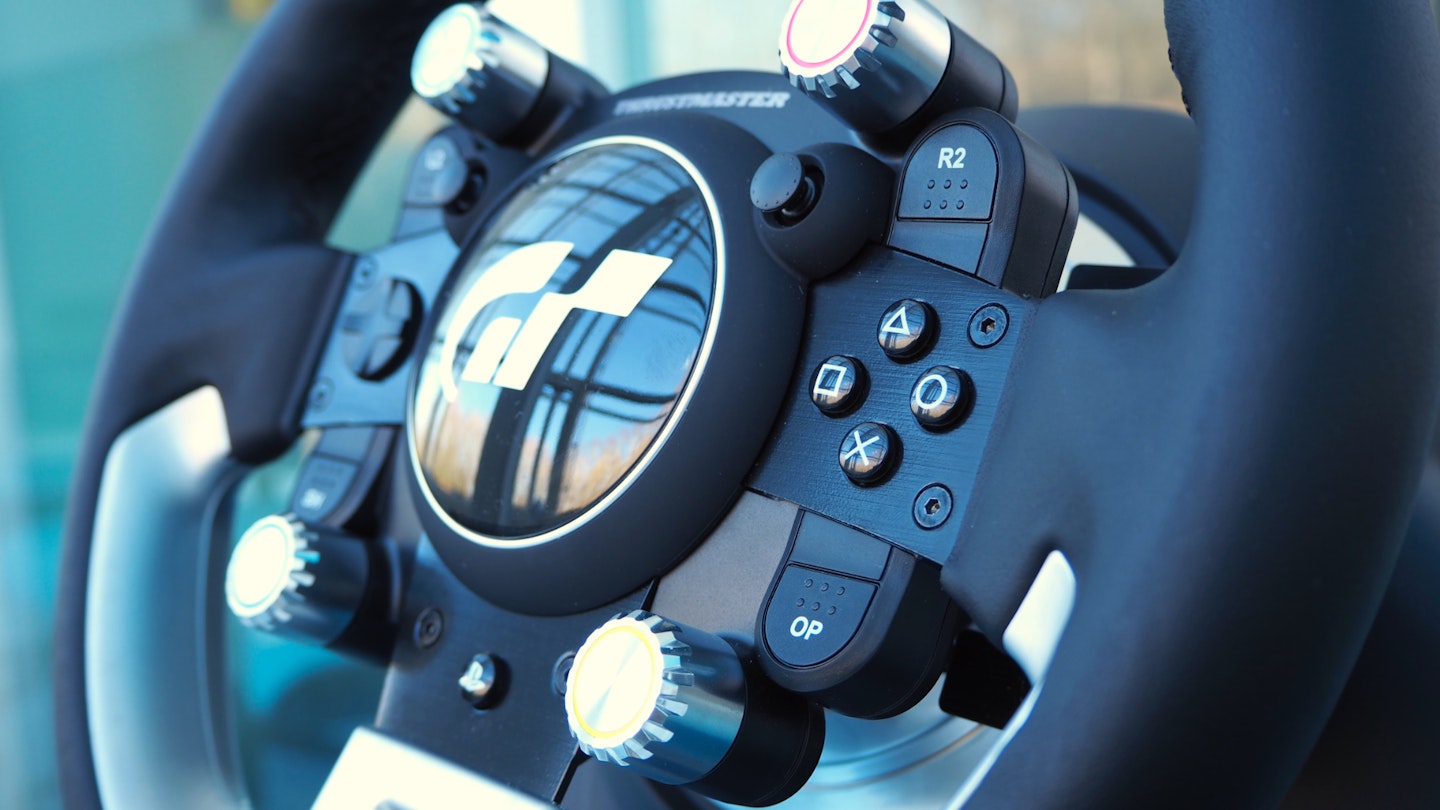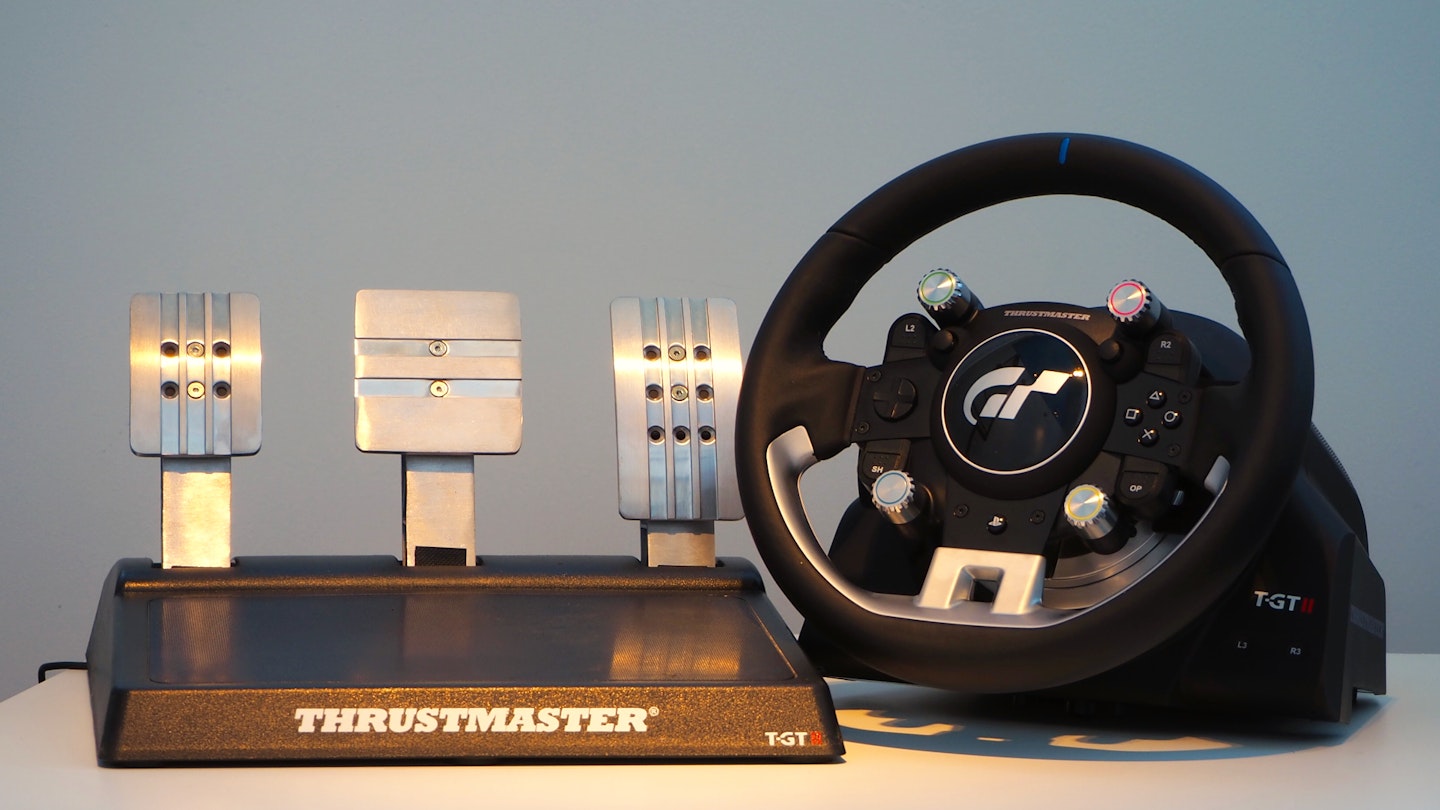► Official racing wheel of Gran Turismo and PS5
► Excellent software tweaks improve force feedback
► But Fanatec offers direct drive at a similar price
Now that direct drive is the cream of sim racing wheel technology, it was a bold move by Thrustmaster to release a belt-driven racing wheel in 2021 that cost £700 (including pedals). Consequently, the Thrustmaster T-GT II has been put on the back foot before the box has even been opened because so many people have baulked and said, ‘Well I’m just going to buy a Fanatec direct drive unit instead.’
But the T-GT II comes ready to race and promises an incredibly realistic sim-racing experience and let’s also not forget it’s the official racing wheel for Gran Turismo. What we want to establish here is whether this official racing wheel is worth the dough. Sure, Rolex is the official timepiece of Formula One but should you get one?
During our time with the T-GT II we’ve used it on PlayStation 4 and 5 and with three different types of racing games: Gran Turismo 7, the more hardcore and recently updated Assetto Corsa Competizione, and the more arcade DiRT 5. This allowed us to find out how the T-GT II performed in most sim racing scenarios, on sealed tarmac and rally driving alike, to give all that new tech a real workout.

Also available from:
Jump to:
A quick overview before we race

Everything you need to rip up the virtual track is included in the box: the base, detachable T-GT II wheel, T3PA GT II pedal set (the wheel can be bought on its own), power supply and cable, and clamping system.
It’s a heavy unit, weighing more than 13 kilograms and it, therefore, needs to be mounted to something that can take both the weight and the feedback. Don't blow your sim rig budget on this and then scrimp on a £50 stand, which will bend when mounting the wheel and then fold inside out when you start racing.

No doubt you’ll notice the T-GT II looks like a facelift of the T-GT, if you are familiar with the predecessor. Indeed, the T-GT II has the same button layout as its dad and even uses the same 40W brushless motor.
Regarding the layout, we don’t have any qualms because it’s excellent for PlayStation and PC use, though of course does render it incompatible with Xbox. That motor does have plenty of power, it’s just whether it can improve on the feel of the T-GT, which is something we certainly expect. There have been tweaks that allegedly address this.
T-GT II on Gran Turismo 7

There’s little point in tiptoeing around the fact that the T-GT II is wonderful and in a different league to cheaper belt-driven wheels like the Logitech models. There’s so much more feel and it arrives on time like a Swiss commuter train. One of the improvements over its predecessor is the Real Time Force Feeback (T-RTF), which hastens the calculation of force feedback to the point where it’s essentially immediate.
One of the big problems with a lesser racing wheel is it behaves like a British commuter train, i.e., it’s late. The feedback doesn’t kick in at the time of the action and you are left reacting to rather than dictating the car’s behaviour. It’s a totally different story with the T-GT II. You feel like you’re actually driving rather than operating a dial. This upgrade works for all games.

Of course, the primary reason why this wheel is officially for Gran Turismo is because of that little switch on the base that flicks the T-GT II between ‘Other’ and ‘GT’. When it’s set to ‘Other’, the force feedback works but the Depth Feedback (T-DFB) does not.
In ‘GT’ setting, both are working. The Depth Feedback is software that works specifically for Gran Turismo 7 and Sport and adds some extra precision in the steering. This is something that was brought over from the T-GT. It works, helping you feel under and oversteer a bit more clearly, but it doesn’t make as radical a difference as the T-RTF tech does.
Because Gran Turismo 7 is a racing game for all, it demands a racing wheel that can cope with many scenarios, not just laser-precise tarmac runs. If you want to fool around in an oversteering Lotus Elise the T-GT II will cater to that just as well as it will with an over-tuned Fast And Furious-style Honda Integra Type R.
T-GT II on Assetto Corsa Competizione

Wiping away our Gran Turismo grins we took the T-GT II into the serious world of Assetto Corsa Competizione (ACC). This highly realistic sim racing game does demand the precision of a racing wheel, whereas Gran Turismo does not strictly. Thus, the T-GT II’s software improvements are more obvious than when being used on Gran Turismo.
On ACC, you have to be smooth with your steering inputs like in real life otherwise you end up everywhere except the tarmac. We won’t pretend that the belt-driven system, excellent though it is, is as honest as the direct drive is, but it’s only something you'll whine about if you’re an ambitious and determined sim racer.
It’s like the difference between the McLaren GT and 720S. The former is a truly magnificent machine more than capable of keeping up with most peoples’ talents, while the 720S provides that extra feel and performance that only the very best of us really need.
Speaking of the 720S, it was its GT3 version that we were careering around Spa in ACC and the T-GT II was smooth, responsive (even without the exclusive ‘GT’ software), and very quiet. There were no dead zones in the feedback (thanks again T-RTF). Also, the quality of the wheel stands out more in this kind of sim racing setting. The paddle shifters are so satisfying to use with their confident clicks and while the wheel diameter isn’t full size (28cm), its shape and leather wrap is very comfortable.

Thrustmaster has also added some extra durability to the T-GT II by making its circuit boards compliant with Automotive Electronics Council standards. In the same way that personal electronic devices carry IP ratings, it’s good to know that the T-GT II has upped its quality in part exchange for the hefty asking price.
The pedals are the weakest link in the chain. They are much firmer than Logitech pedals and well put together, but they aren’t load cell. Therefore, they don’t measure the force of the push, instead it’s about the distance. You can get the T-GT II without the T3PA GT II pedals and buy Thrustmaster’s T-LCM load cell pedals separately. It would up the total cost to about £850 but worth it if you desire realism.
T-GT II on DIRT 5

There’s no greater challenge for force feedback than with rally driving. Partly because of the loose surface but also because the style of driving, you’re constantly setting up a series of consequential moves like in a complex dance sequence. And the wheel needs to be communicating car behaviour so you know when you can implement the next part.
As with Gran Turismo 7 and ACC, the T-GT II’s Real Time Force Feedback was a star. It works in conjunction with something called Drift Curve Calculation, also known as T-DCC. (Yes, the collection of acronyms is tiresome but we live in an acronymic world.)
What the T-DCC does is use maths to help make controlling slides easier. That came into immediate effect in DIRT 5 – and Gran Turismo – allowing us the pull off Scandi flicks with increasing frequency and the driving dynamics of DIRT 5 are complex enough to make that achievement. It’s even more so when playing Gran Turismo 7.
Frankly, it’s unlikely you’ll be splurging out on a £700 racing wheel for the more arcade-type action like you get on DIRT 5. But if these are games you happen to have in addition to your more serious racing games, it’s certainly good to know the T-GT II will make your racing experience better, no matter the game.
Verdict

We’ve established that the T-GT II is a very good racing wheel. But let’s answer the important question: is it worth that asking price? Logitech’s G923 stands as a benchmark for entry-level racing wheels at £350, so the T-GT II is twice the price. In a similar scenario, Mini’s Convertible is about £24,000 and the Porsche 718 Boxter is about £48,000. Is the Thrustmaster twice the racing wheel and the Porsche twice the car? In both cases, it depends what you’re looking for.
If you’re someone who enjoys racing games and wants the extra bit of realism a racing wheel gives you, then the G923 will serve you very well, in the same way a Mini Convertible will offer the affordable thrill of an open top car. But for pushing further into the realm of performance, neither the Logitech nor the Mini will cut the mustard and that’s where you need the Thrustmaster and the Porsche.
But that's not the end of the story. There is an obvious complexity with the T-GT II that makes things tricky. Fanatec offers 5Nm and 8Nm direct-drive bundles (Gran Turismo DD Pro) including wheels and pedals costing around 600 and 850 euros respectively. These are compatible with PlayStation, PC, and Xbox and provide a seriously enticing alternative.
The Fanatec bundles don’t have load cell pedals either and are only twin pedals compared to the three you get with the T-GT II and the layout of the T-GT II is better. Another important consideration is that you really need a strong rig to accommodate the torque of direct drive.
However, the Fanatec wheel does offer even more clarity and responsiveness. It’s more precise and a more pleasurable wheel to use. Thrustmaster has produced an excellent racing wheel with the T-GT II but direct drive is available at a similar price and when that’s the case, it’s the way to go if you're serious about your sim racing. But for Gran Turismo fans in particular, the T-GT II is a very good wheel indeed.

| Specs | |
|---|---|
| Weight | 13.15kg |
| Dimensions (W/D/H) | 525/380/310mm |
| Compatibility | PS5, PS4, PC |
| Motor | T-40VE 40-watt brushless |
| Pedals | T3PA GT II pedal set |

Other opinions from the CAR team
Ryan Gilmore: If you’re serious about racing games and want a top-quality wheel with plenty of feedback, I can’t recommend the TGT II enough. The standout aspect of this wheel for me is how well it adapts to racing games right across the spectrum. From arcade racers like DIRT 5 to the infuriatingly accurate Assetto Corsa Competizione the wheel adapts well and never feels unnatural.
It’s definitely a learning curve but feels so satisfying to get right too. Just make sure you have a sturdy table or proper rig to mount the wheel on or the torque will break it free.
Adam Binnie: The steering column feedback on Gran Turismo is great and gives you a much better idea what the front wheels are doing before they lose traction. Thumbsticks mean it has exactly the same functions as a controller (Logitech's G29 doesn't have these); the shifters had a really nice positive click, so no missed shifts; quality is high, especially the leather around the rim and the machined metal knobs. But the T-GT II could do without the shiny silver plastic at the bottom.
The extra features for Gran Turismo are good if that's all you play but for everyone else a direct drive wheel isn't much more and would be a better upgrade. Overall it's quite a bit nicer than the Logitech G29 but doesn't feel like a massive upgrade in terms of performance, although the fact it's not direct drive means you can mount it on less full-on rigs, like our Next Level Racing F-GT Lite.
Will Lobley: The T-GT II adds a huge sense of fun to racing titles. Its powers are clearly most apt for more hardcore sims like Gran Turismo 7 and Assetto Corsa, but it also pulls off big arcade energy with ease. DIRT 5 was incredible fun with the T-GT II, with the feedback adding to the sense of chaos. It also amplified DIRT’s sense of speed and momentum.
While it's generally easy to set up, it had occasional setting freak-outs when switching between games - mostly with Assetto Corsa Competizione. DIRT 5 and Gran Turismo 7 were easy plug-and-play.
